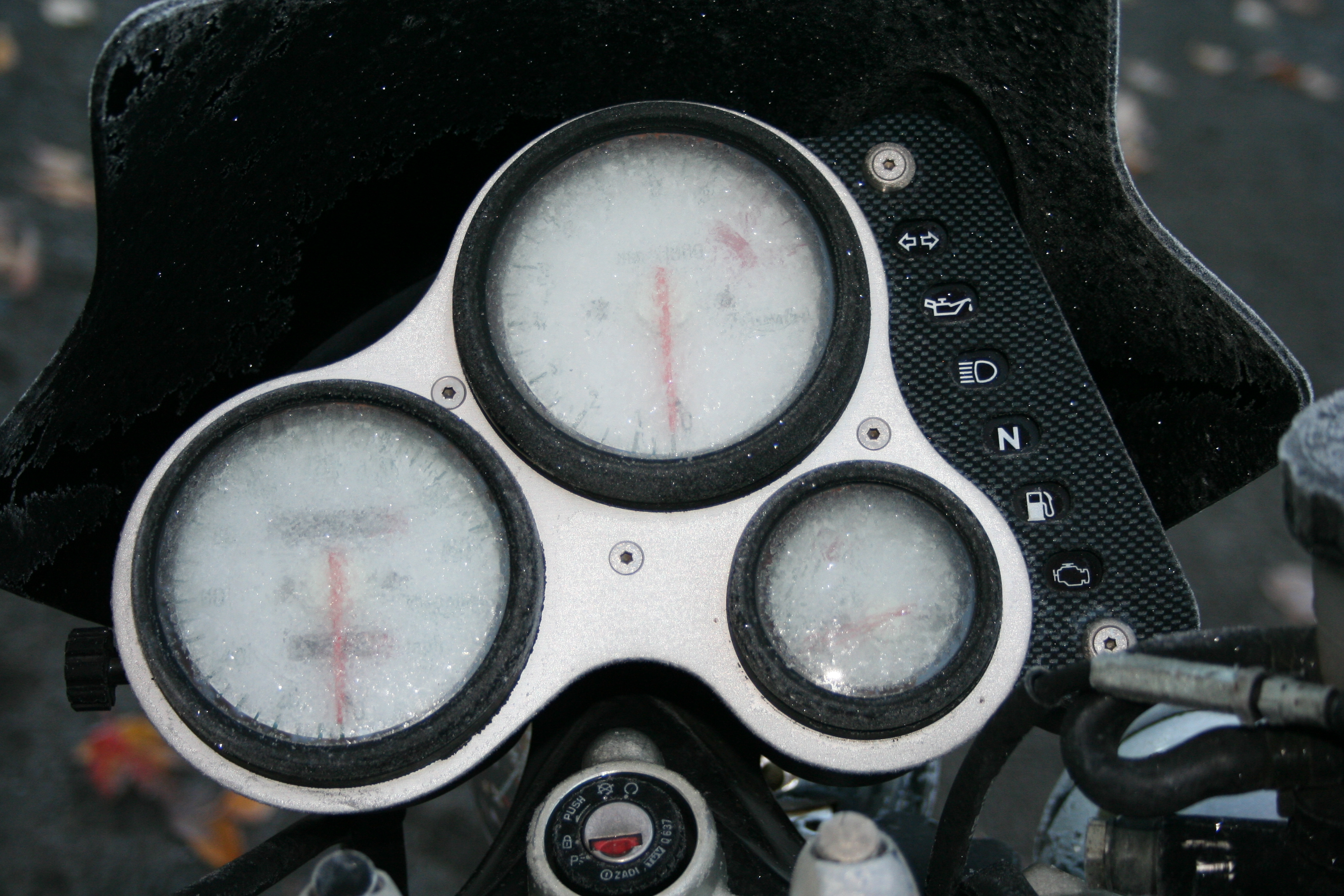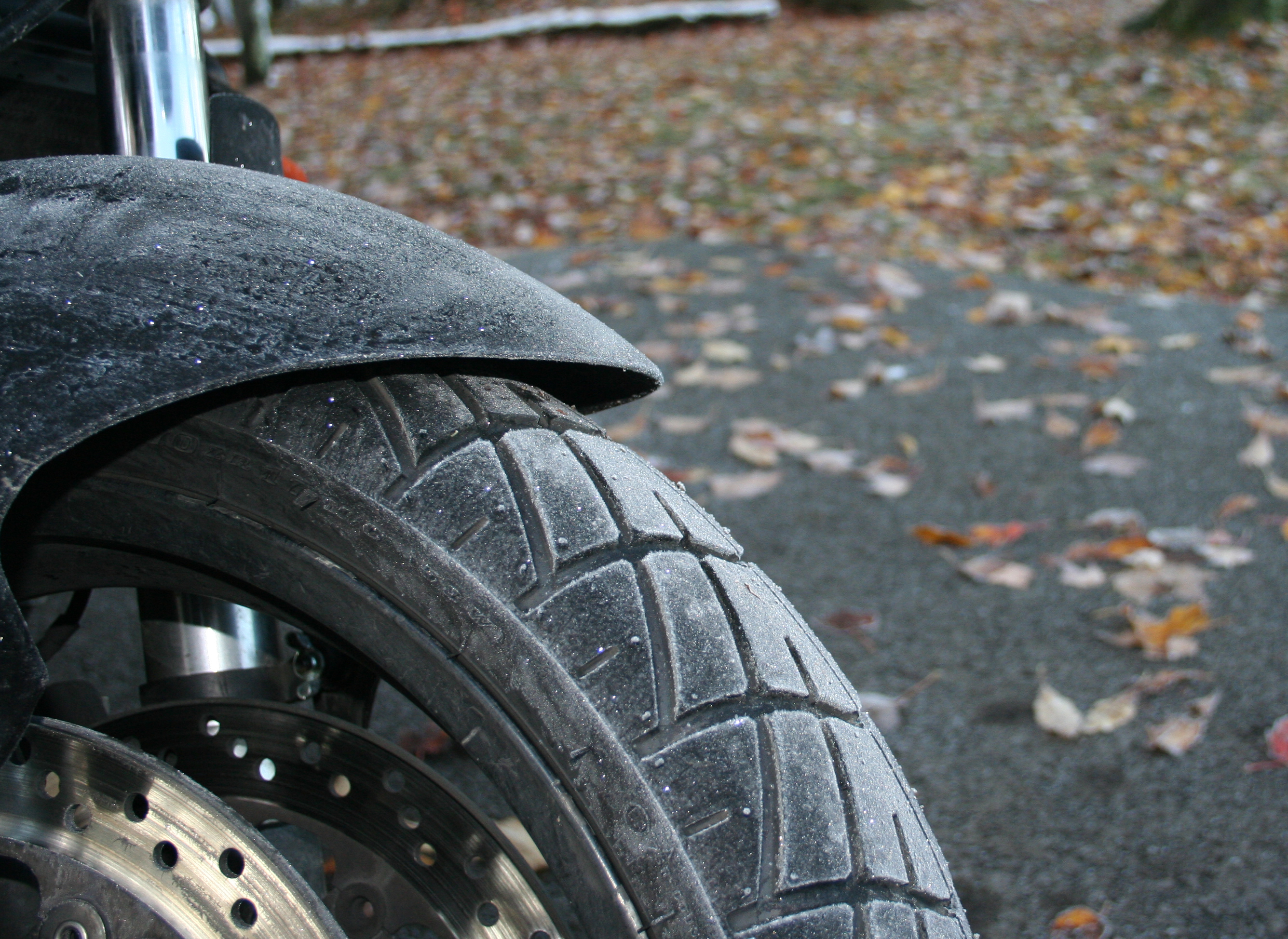When I lived 18 degrees north of the equator, riding my motorcycle all year long was easy. Now that I’m almost 40 degrees north, I still ride 12 months of the year, but it takes more planning, preparation and caution.
Obviously, I don’t ride as far or nearly as often in the winter, but since I work at home and live within walking distance of all the essentials, I can still rely on my motorcycles for transportation without much inconvenience. And being able to get out, even for short, utilitarian rides, improves my mood in the cold months when I’m missing my former life in the tropics. So if you live in the north and want to avoid a long winter cold-turkey layoff from riding, here are my suggestions for being prepared.

Cold-weather riding is never as fun as a warm summer day, but it often beats no riding at all. And with the right preparation, it can be fun.
10 winter riding tips
- Where I draw the line: snow and ice. I’ve known some people to ride on the street with studded tires (laws vary, so check locally) and it can be fun and instructional to ride around in a snowy field on a light dirt bike, but personally I don’t ride on the street when there’s any ice or snow. I don’t want to be in a situation where I don’t have the traction to deal with normal traffic dangers that arise. Twice while commuting, about 25 years apart, I’ve been caught on the street in unexpected snow. Fortunately, both times I was within a few miles of my destination, but both times I felt lucky to survive unscathed. We all have to determine our own risk tolerance, but ice or snow is where I personally draw the line.
- Watch for hidden ice. Though I don’t intentionally go out in icy conditions, I’m still vigilant. Even if it’s sunny and dry with temperatures in the 40s, it’s possible for frost or ice to linger in shaded areas. In winter weather, it’s even more important to scan constantly for potential threats because you may encounter…
- Other winter road hazards. Some riders won’t ride in winter just because of the damage the salt on the roads will do to the appearance of their motorcycles. (I also have a suggestion for that below, if you’re among them.) But many forget that salt can also reduce traction, whether it has been ground to dust by passing vehicles or is still like gravel after being freshly strewn. Other jurisdictions spread cinders, especially at intersections (helpful for cars, treacherous for motorcycles). And of course the harsh winter freeze-and-thaw cycles can quickly open up potholes. Be alert for all these potential hazards.
- Beware cold tires. I’ve only had two minor, low-speed crashes on the street in the past 20 years and both happened on especially cold April mornings, both within a mile of my house and both therefore on cold tires. I know cold tires offer less grip, but knowledge is useless if you don’t act on it. Braking, accelerating and leaning all must be moderated in cold weather, especially at the beginning of the ride.
- Speaking of tires, choose accordingly. Lots of northerners put snow tires on their cars for the season. The motorcycle equivalent is considering sport-touring tires instead of more focused sport tires for a high-performance machine, or maybe a 50/50 adventure tire if those fit your bike. Both offer lots of siping to move water and generally are made with compounds that perform well over a wider temperature range than tires made for sticky hot-weather traction.

If your tires are this cold, caution is essential. At least a blockier tread pattern like this one is better suited for the wet weather that’s often part of winter riding.
- Prep your motorcycle. You ride home from work on the short days of winter and arrive in darkness. Staying out in the cold and dark to perform maintenance can be about as appealing as pounding your half-numb fingers with that cold ball-peen hammer in the garage. But maintenance is even more important when salt is corroding vital parts like brake calipers and control cables only get stickier as the lube turns to gunk.
- Maintenance for yourself, too. The longest and coldest ride I’ve done was a few years ago when I traveled from my home in Ohio to RevZilla headquarters in Philadelphia. Temperatures were in the 40s and the sun was shining, so the roads were clear and dry. A 500-mile day is tiring any time, but your body burns more energy in cold weather to generate heat. Extra rest stops, eating right and staying hydrated (cold, dry air can suck moisture out of you without you noticing) are essential. Factor in the need for more rest breaks and fewer hours of sunlight if you’re planning to cover distance.
It’s not only possible to keep riding in winter but also to take the occasional long trip when conditions are right. This photo is about 75 miles into a 500-mile day in February. There was snow on the grass but the roads were clear and mostly dry.
- The cold reduces dexterity. We all react differently to the cold, but personally my biggest challenge in terms of staying warm is keeping my hands from freezing up. I’ve used heated gloves and the combination of heated grips and handguards. Even high quality insulated gloves won’t keep my hands warm on a long, cold ride, and they also limit the feel I have if I need to emergency brake when when a car pulls in front of me. If your hands are stiff and cold, you need to stop and restore blood flow and feeling, period. (See also: How to gear up for winter riding.)
- The cold reduces mental concentration. So a we’ve seen, the cold makes you tired and reduces your fine control over brakes and throttle. There’s one other threat, as my friend Eric Trow, principal at Stayin’ Safe Motorcycle Training, explains: “Perhaps the greatest threat to the rider is the impact hypothermia can have on mental sharpness. Our thinking often slows, our active scanning and anticipation of potential threats diminishes, and our judgment can become seriously compromised. As a result, bad situations seem to develop more quickly and more often.” Be very aware of your own condition and stop to warm up if you don’t feel sharp.
- How to ride all winter: Buy a beater bike. Some people treat a motorcycle like an art object (sometimes with reason) and would never consider taking it on salty roads or risk scratching it up in a tipover. Back when I had a typical Monday-through-Friday commute to an office job, I addressed that issue by buying a very used Honda NX250 for $1,100 and I rode it to work all winter for several years. The dual-sport tires worked well in the cold, the light weight and modest power made it easy to handle in sub-optimal traction conditions and when the salt corroded a bolt on the brake caliper, a replacement caliper on eBay cost me a whopping $30. Riding a $1,000 bike into the ground makes more sense than doing $1,000 in damage to the main motorcycle you love. In my case, I rediscovered the joys of small motorcycles and kept my skills from getting rusty by riding that little beater all winter.
Maybe you just don’t enjoy riding in anything other than great conditions (or maybe you live in Houston and all this is irrelevant), and if so, that’s fine. But if you would like to extend your riding season, maybe start with tip #10 (the most fun one, buying another motorcycle) and then work your way through the others. You might enjoy winter riding more than you expect.

I have found that the key to staying comfortable in the cold is making sure you’re absolutely windtight and waterproof. Seal up any opening where cold air can get it because if it can it will. Don’t forget the space between your jacket and helmet. Waterproof is even more important because if you get wet when it’s cold you can get in big trouble real fast.
That’s definitely good advice. I also have a separate, older article hear about what to wear, specifically, for cold-weather riding.